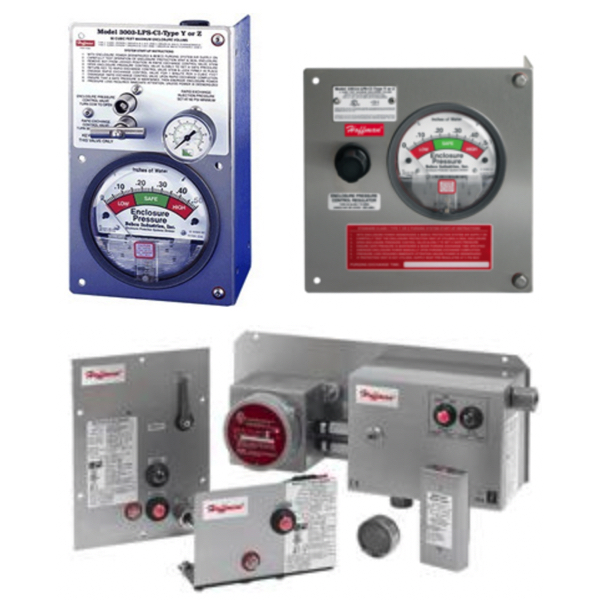Enclosure Pressure Purging

Enclosure pressure purging systems are critical safety solutions for electrical enclosures installed in hazardous or classified environments. RSP Supply carries a full line of enclosure pressure purging systems, including continuous flow and leakage compensation configurations, designed to remove hazardous gases and maintain safe operating conditions for electrical equipment.
Pressure purging works by introducing clean air or an inert protective gas into the enclosure to displace flammable or hazardous gases that may be present. During the initial purge cycle, any potentially explosive atmosphere inside the enclosure is removed. Once purging is complete, the system maintains a positive internal pressure to prevent hazardous gases from entering from the surrounding environment. This approach allows standard electrical equipment to be safely operated in areas where explosive gases, vapors, or dusts may exist.
Continuous flow and leakage compensation systems ensure that positive pressure is maintained even if minor enclosure leaks are present. These systems automatically regulate purge flow and pressure levels to compensate for air loss, ensuring consistent protection. Control units monitor pressure conditions and manage purge cycles, supporting compliance with safety standards such as those established by the National Fire Protection Association (NFPA).
Enclosure pressure purging systems are engineered based on enclosure size, hazard classification, and application requirements. They are widely used in industrial facilities, oil and gas operations, chemical processing plants, and other environments where explosion-proof solutions may be impractical or cost-prohibitive. By maintaining a controlled internal atmosphere, pressure purging systems help protect equipment, reduce corrosion, and support reliable long-term operation in hazardous locations.
More Information about Enclosure Pressure Purging
These systems work by first initiating an initial purge, which clears any hazardous or flammable gas from the enclosure. Following the purge, the enclosure is pressurized to maintain a constant flow of protective gas. This pressurization helps to create a barrier against the entry of hazardous gases from the outside, thus protecting the internal equipment. The use of protective gas supply, such as an inert gas supply, is a key component in these systems. Inert gases are preferred as they do not react with the electrical components or with other potentially explosive materials within the enclosure. Additionally, the system often includes features for leakage compensation, ensuring that the positive pressure inside the enclosure is maintained even if there are minor leaks.
The design of pressurization systems takes into account the specific needs of the electrical enclosures they protect. This includes considerations for the size of the enclosure, the type of hazardous gases or flammable substances present, and the requirements for safe operation in hazardous locations. The systems are often controlled by a control unit, which manages the purge flow rate and the maintenance of positive pressure, ensuring both the safety of the protected equipment and compliance with safety standards like those set by the National Fire Protection Association. Enclosure pressure purging, through the use of purge and pressurization systems, is a vital safety measure for electrical enclosures in hazardous areas. By purging hazardous gases and maintaining a protective atmosphere of inert gas or clean air, these systems safeguard electrical equipment from the risks of explosion or fire, while ensuring continuous and safe operation in challenging environments.
FAQs
Q: What is enclosure pressure purging used for?
Enclosure pressure purging is used to remove hazardous or flammable gases from an enclosure and maintain a positive internal pressure to prevent gas ingress.
Q: What happens during the initial purge cycle?
The initial purge cycle removes any hazardous or explosive atmosphere inside the enclosure before electrical equipment is energized.
Q: What is leakage compensation in a purge system?
Leakage compensation automatically maintains positive pressure by adjusting airflow when minor enclosure leaks are present.
Q: What gases are used in pressure purging systems?
Clean air or inert gases are commonly used to purge and pressurize enclosures safely.
Q: Can pressure purging replace explosion-proof enclosures?
In many applications, pressure purging allows standard enclosures to be used safely in hazardous areas, eliminating the need for explosion-proof enclosures when properly designed and installed.
Why Buy Enclosure Pressure Purging Systems from RSP Supply
RSP Supply offers a comprehensive selection of enclosure pressure purging systems designed for continuous flow and leakage compensation in hazardous environments. Our solutions help ensure safety, regulatory compliance, and reliable equipment operation while reducing system complexity. Customers rely on RSP Supply for trusted purge system components, competitive pricing, and knowledgeable technical support.

